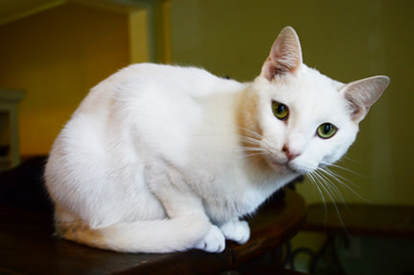
Not only are white cats rare and valuable, they are also vulnerable. Why? Because the white of their coat isn’t actually a color, but the ABSENCE of color. And why is this so vital? Because these exquisitely beautiful cats have no protection against the sun’s harmful ultraviolet rays.
The variety and distribution of natural “dyes” in the skin and fur of cats are responsible for their coats’ colors and patterns. One such “dye” is melanin, the main protector against ultraviolet radiation in cats just as in humans. White cats have either no melanin or very little, putting them at high risk of both sunburn and skin cancer.
For the owners of white cats, protection is paramount: keep kittens indoors from birth and keep adopted or grown cats’ sun exposure to a minimum. If, however, your particular kitty is content to simply BE outdoors without roaming, tether her to a tree or post in a shaded area and watch her closely as she watches the birds and squirrels. For cats used to coming and going, apply a sun-block cream to their ear rims, nose, eyelids and lips, and restrict their outdoor time to the late afternoon and early evening.
In the absence of protection and often, despite it, white cats exposed to the sun are likely to get sun burnt. With repeated exposure, these sunburns will, more often than not, become cancerous. Concerned owners should check for reddened bumps on kitty’s ear rims and around her nose, eyes and lips, which, unlike insect bites or allergic reactions, are seldom itchy. The sooner kitty’s seen by a vet, the better the chances of controlling her cancer since this form of skin cancer often responds well to treatment. It is, of course, only a temporary solution if the cat remains exposed to the sun.
Cats with pure, snow-white coats are part of a diverse population depending on the color of their eyes. Example: white cats with blue eyes are missing a surface “dye” in their eyes as well as in their coats. Blue eyes in adults signify an absence of color in the upper layers of the iris. What appears blue is, in reality, black, due to the “black dye” melanin in the deeper layer of the iris.
These cats are also often deaf, since the gene responsible for iris color is linked to the gene responsible for hearing. Quite naturally, deaf cats require extra care. They should never be left outdoors where they’re vulnerable to dangers such as approaching cars, aggressive dogs and other assorted predators. If taken outside, they must be walked on a leash or tethered nearby and closely monitored. In addition, deaf cats make poor mothers because they can’t hear their kittens’ mewing.
Many white cats have one blue eye and one green eye. Green, unlike blue, means the presence of color. These particular cats are deaf in only one ear, although not necessarily on the same side as the blue eye. Other white cats have orange eyes, resulting from a color located above the black melanin. Albinos suffer from a total lack of melanin in their skin, fur and eyes (their eyes seem red because you can see through their colorless outer layers to the blood vessels in the iris), and are exceedingly rare.









 RSS Feed
RSS Feed